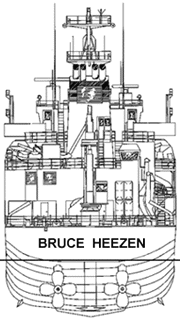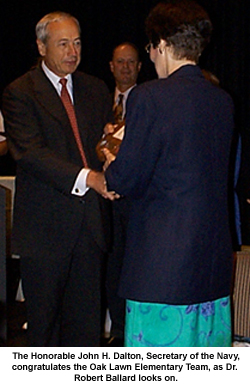
by the Secretary of the Navy


|
|
Official Ship Naming by the Secretary of the Navy |
In an unprecedented move - the first in the Navy's history - the Honorable John Dalton, Secretary of the Navy, disclosed tonight that a group of nine fifth graders from Cranston, Rhode Island has found a name for Navy's newest oceanographic survey ship (T-AGS 60 class). The new ship, he announced, will be called the USNS BRUCE HEEZEN (pronounced HAY-zin), after the 20th-century pioneering marine investigator who aided in our understanding of plate tectonics, and produced the famous Heezen-Tharp physiographic maps of all the major oceans of the world.
As the National Champions for Division 1 (K-6th grade) in a nationwide Navy contest to find a name for the new ship, the nine fifth-graders from Oak Lawn Elementary School in Cranston were in town to hear the Secretary's announcement at a ceremony at the U.S. Navy Memorial. The Division 2 National Champion (7-12th grade), St. Martin's Lutheran School of Annapolis, Maryland, was also honored during this exciting, non-traditional Navy ceremony. Secretary Dalton announced that the next Navy satellite mission that will study the oceans from space, will be named CORIOLIS -- the name the St. Martin's Team had proposed for the new ship.
Both teams successfully competed in the contest that began at the start of the school year last September and prompted nearly 2,000 proposals for the new ship's name. According to contest rules, each school had to suggest a name, defend the proposal, and work on interdisciplinary projects to prove that they had done research and study on the oceans. The competition was Internet based in that all rules, criteria, and research information was posted to a Navy Website to which the students were directed.
Both the Cranston school and the Annapolis school first won their State competitions and then were judged by a national panel that selected them as the best in their Divisions. The ceremonial event, the numerous plaques and gifts, the trip to Washington, and tours of the city were their rewards for their achievements. Dr. Robert Ballard, the renowned oceanographer and discoverer of the TITANIC, was the guest speaker. He praised the accomplishments of these students, and encouraged their continued involvement with the oceans. The Cranston team will travel to Moss Point, Mississippi this December to attend the launch and christening of the USNS BRUCE HEEZEN at the Halter Marine Shipyard.

The U.S. Navy Oceanographic Ship Naming Competition was a departure from customary Navy tradition in ship naming procedures. In general, professional Navy historians send recommendations up to the Secretary of the Navy, who chooses a name for new ships among these.
Initiated by the Oceanographer of the Navy, Rear Admiral Paul Tobin, and authorized by the Secretary of the Navy, the contest was designed to coincide with the International Year of the Ocean to get students involved in studies about the oceans, the history of seafaring, and related subjects. It also urged the use of the Internet and the World Wide Web. Students were encouraged to visit the contest's Web page (http://oceanographer.navy.mil) in their classrooms and schools, or through community resources.
To enter the contest, students were instructed to form teams to research and propose a name. Each team prepared a related project to support and justify their proposed name. These projects were judged on imagination and creativity, and evidence of educational value. Proposed names could be the names of former vessels used in exploration, discovery, science, research, experimentation, or adventure. They could be names of former vessels remembered for their achievement and derring-do on the oceans in the pursuit of freedom and/or scientific excellence. They could be names of former men and women whose work linked them to the oceans (they could not be named for those currently living). Or, they could be names that simply captured the spirit of ships and seafaring.
Students in public, private, and home schools from the U.S., U.S. territories, overseas dependents schools, and Bureau of Indian Affairs schools were all eligible to participate. Posters advertising the contest were mailed to over 115,000 schools at the start of the school year.
In addition to various agencies within the United States Navy that helped coordinate the contest, the Navy League of the United States, and the Navy Memorial Foundation helped fund the competition and its events.
The Navy's fleet of oceanographic survey ships criss-cross the world's oceans conducting oceanographic surveys. Besides mapping the ocean floor to update nautical charts, these ships typically conduct oceanographic sampling of the physical properties of the water column as well as the composition of the ocean floor, launch and recover instrument packages, conduct acoustic property measurements, and possess the capability to process and analyze the data onboard with the latest computer technology.
All the Navy's oceanographic survey ships carry the latest in over-the-side sensors and sampling equipment including bathythermographs, bottom corers, and seismic equipment. Seventy-five percent of the oceans either have never been surveyed or were surveyed many years ago using crude instruments. Since the days of Navy's earliest oceanographers, the Oceanographer of the Navy's mission in supporting Navy Fleet operations has grown to include interpreting the entire ocean and weather, both for ensuring safety of operations and providing a tactical "edge" in utilizing that environment for our own use.
Office of the Oceanographer of the Navy:
Office of the Navy Chief of Information:
703-697-5342